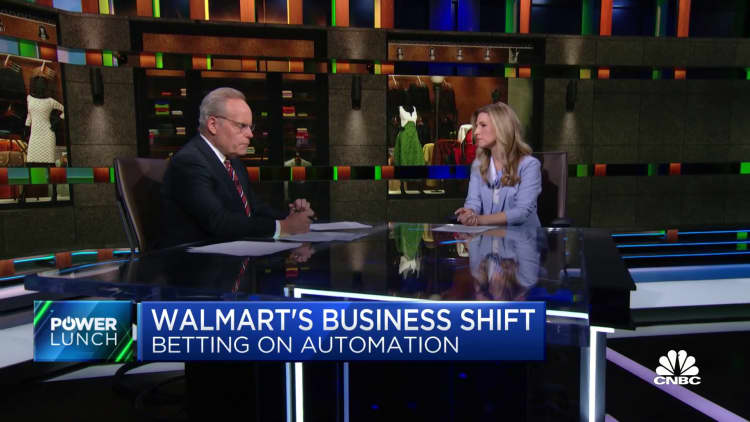Walmart warehouse automation powers higher profits

BROOKSVILLE, Fla. — At first glance, this warehouse looks like many: Forklifts unload pallets from the back of dozens of tractor trailers. Canned soup, soda and cleaning supplies whiz by on conveyer belts. Store-bound merchandise gets sorted by department and store aisle before getting stacked high like an elaborate game of Tetris.
The difference? Tasks are powered by giant automated claws and rolling robots, instead of people. The driver’s seats on the forklifts are empty.
Welcome to the future of Walmart.
The big-box retailer at an investor event last week previewed how it plans to use automation to more quickly and cost effectively manage inventory, stock shelves and keep up with online orders. The company took investors on a tour of an approximately 1.4 million-square-foot facility in Brooksville, Florida — the first automated distribution center for packaged foods and other shelf-stable household items.
Walmart plans to add that same automation from Symbotic — a warehouse technology company that Walmart took a majority stake in last year — to all of its 42 regional distribution centers, though it didn’t share a timetable for doing so. By the end of January, roughly a third of stores will get distribution from the automated facilities, the company said.
Walmart’s automation is a piece of a broader plan to drive profits higher. CEO Doug McMillon said in the coming years the retailer’s revenue will grow about 4% year over year — a slower growth rate than the approximately 8% it saw in the past three pandemic-fueled years, but still faster than growth of 3.1% and 3.6% the retailer posted in the three years prior to the pandemic.
McMillon added that he expects profits to grow at a quicker pace than sales over the next five years as Walmart adds automation and grows its higher-margin businesses like advertising, last-mile delivery and fulfillment services.
He said Walmart has given customers more ways to shop online and get those purchases faster. It offers more general merchandise, including exclusive brands in categories like apparel. And it has more sellers that have joined its third-party marketplace, too.
“We’re now in a phase that is less about scaling store pickup and delivery, e-commerce assortment, and e-commerce FC [fulfillment center] square footage and more about execution and operating margin improvement,” he said.
In three years, Walmart anticipates that about two-thirds of its stores will be serviced by some kind of automation, about 55% of fulfillment center volume will move through automated facilities and that unit cost averages could improve by about 20%.
Workforce shifts
For Walmart, the country’s largest employer, the automation push means rendering obsolete some of its 1.6 million roles.
At the Brooksville facility during the investor tour, few people appeared to be on the distribution center’s floor, though Walmart said its overall headcount at the facility hasn’t changed.
David Guggina, executive vice president of Walmart…
Read More: Walmart warehouse automation powers higher profits
